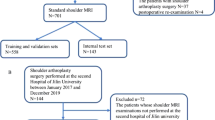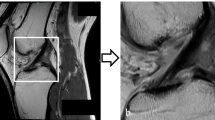Abstract
Rotator cuff tears (RCTs) are one of the most common shoulder injuries, which are typically diagnosed using relatively expensive and time-consuming diagnostic imaging tests such as magnetic resonance imaging or computed tomography. Deep learning algorithms are increasingly used to analyze medical images, but they have not been used to identify RCTs with ultrasound images. The aim of this study is to develop an approach to automatically classify RCTs and provide visualization of tear location using ultrasound images and convolutional neural networks (CNNs). The proposed method was developed using transfer learning and fine-tuning with five pre-trained deep models (VGG19, InceptionV3, Xception, ResNet50, and DenseNet121). The Bayesian optimization method was also used to optimize hyperparameters of the CNN models. A total of 194 ultrasound images from Kosin University Gospel Hospital were used to train and test the CNN models by five-fold cross-validation. Among the five models, DenseNet121 demonstrated the best classification performance with 88.2% accuracy, 93.8% sensitivity, 83.6% specificity, and AUC score of 0.832. A gradient-weighted class activation mapping (Grad-CAM) highlighted the sensitive features in the learning process on ultrasound images. The proposed approach demonstrates the feasibility of using deep learning and ultrasound images to assist RCTs’ diagnosis.
Graphical abstract







Similar content being viewed by others
Abbreviations
- AUC:
-
Area under the curve
- CNN:
-
Convolution neural network
- CT:
-
Computed tomography
- DL:
-
Deep learning
- FN:
-
False negative
- FP:
-
False positive
- Grad-CAM:
-
Gradient-weighted class activation mapping
- MRI:
-
Magnetic resonance imaging
- RCTs:
-
Rotator cuff tears
- ROC:
-
Receiver operating characteristic
- TN:
-
True negative
- TP:
-
True positive
References
Via AG, De Cupis M, Spoliti M, Oliva F (2013) Clinical and biological aspects of rotator cuff tears. Muscles Ligaments Tendons J. 3(2):70–9. https://doi.org/10.11138/mltj/2013.3.2.070.
Craig R, Holt T, Rees JL (2017) Acute rotator cuff tears. BMJ 11(359):j5366. https://doi.org/10.1136/bmj.j5366
Goutallier D, Postel JM, Bernageau J, Lavau L, Voisin MC (1994) Fatty muscle degeneration in cuff ruptures. Pre- and postoperative evaluation by CT scan. Clin Orthop Relat Res 304:78–83. https://doi.org/10.1097/00003086-199407000-00014
Lapner PL, Jiang L, Zhang T, Athwal GS (2015) Rotator cuff fatty infiltration and atrophy are associated with functional outcomes in anatomic shoulder arthroplasty. Clin Orthop Relat Res 473(2):674–682. https://doi.org/10.1007/s11999-014-3963-5
Gladstone JN, Bishop JY, Lo IK, Flatow EL (2007) Fatty infiltration and atrophy of the rotator cuff do not improve after rotator cuff repair and correlate with poor functional outcome. Am J Sports Med 35(5):719–728. https://doi.org/10.1177/0363546506297539
Donohue KW, Ricchetti ET, Ho JC, Iannotti JP (2018) The association between rotator cuff muscle fatty infiltration and glenoid morphology in glenohumeral osteoarthritis. J Bone Joint Surg Am. 100(5):381–7. https://doi.org/10.2106/JBJS.17.00232
Thomazeau H, Rolland Y, Lucas C, Duval JM, Langlais F (1996) Atrophy of the supraspinatus belly. Assessment by MRI in 55 patients with rotator cuff pathology. Acta Orthop Scand 67(3):264–8. https://doi.org/10.3109/17453679608994685
van de Sande MA, Stoel BC, Obermann WR, Tjong a Lieng JG, Rozing PM. (2005) Quantitative assessment of fatty degeneration in rotator cuff muscles determined with computed tomography. Invest Radiol 40(5):313–319. https://doi.org/10.1097/01.rli.0000160014.16577.86
Oh JH, Kim SH, Choi JA, Kim Y, Oh CH (2010) Reliability of the grading system for fatty degeneration of rotator cuff muscles. Clin Orthop Relat Res 468(6):1558–1564. https://doi.org/10.1007/s11999-009-0818-6
Slabaugh MA, Friel NA, Karas V, Romeo AA, Verma NN, Cole BJ (2012) Interobserver and intraobserver reliability of the Goutallier classification using magnetic resonance imaging: proposal of a simplified classification system to increase reliability. Am J Sports Med 40(8):1728–1734. https://doi.org/10.1177/0363546512452714
McElvany MD, McGoldrick E, Gee AO, Neradilek MB, Matsen FA 3rd (2015) Rotator cuff repair: published evidence on factors associated with repair integrity and clinical outcome. Am J Sports Med 43(2):491–500. https://doi.org/10.1177/0363546514529644
Terrier A, Ston J, Dewarrat A, Becce F, Farron A (2017) A semi-automated quantitative CT method for measuring rotator cuff muscle degeneration in shoulders with primary osteoarthritis. Orthop Traumatol Surg Res 103(2):151–157. https://doi.org/10.1016/j.otsr.2016.12.006
Park J, Kim S, Lim JK, Jin KN, Yang MS, Chae KJ et al (1985) (2021) Quantitative CT image-based structural and functional changes during asthma acute exacerbations. J Appl Physiol 131(3):1056–1066. https://doi.org/10.1152/japplphysiol.00743.2020
Yoon S, Tam TM, Rajaraman PK, Lin CL, Tawhai M, Hoffman EA et al (1985) (2020) An integrated 1D breathing lung simulation with relative hysteresis of airway structure and regional pressure for healthy and asthmatic human lungs. J Appl Physiol 129(4):732–747. https://doi.org/10.1152/japplphysiol.00176.2020
Klibanov AL, Hossack JA (2015) Ultrasound in radiology: from anatomic, functional, molecular imaging to drug delivery and image-guided therapy. Invest Radiol 50(9):657–670. https://doi.org/10.1097/RLI.0000000000000188
Grassi W, Filippucci E, Busilacchi P (2004) Musculoskeletal ultrasound. Best Pract Res Clin Rheumatol 18(6):813–826. https://doi.org/10.1016/j.berh.2004.05.001
Tan A (2003) Imaging of the musculoskeletal system: magnetic resonance imaging, ultrasonography and computed tomography. Best Pract Res Clin Rheumatol 17(3):513–528. https://doi.org/10.1016/s1521-6942(03)00021-4
Saraya S, El Bakry R (2016) Ultrasound: can it replace MRI in the evaluation of the rotator cuff tears? Egypt J Radiol Nucl Med 47(1):193–201. https://doi.org/10.1016/j.ejrnm.2015.11.010
de Jesus JO, Parker L, Frangos AJ, Nazarian LN (2009) Accuracy of MRI, MR arthrography, and ultrasound in the diagnosis of rotator cuff tears: a meta-analysis. AJR Am J Roentgenol 192(6):1701–1707. https://doi.org/10.2214/AJR.08.1241
Hashimoto F, Kakimoto A, Ota N, Ito S, Nishizawa S (2019) Automated segmentation of 2D low-dose CT images of the psoas-major muscle using deep convolutional neural networks. Radiol Phys Technol 12(2):210–215. https://doi.org/10.1007/s12194-019-00512-y
Weber KA, Smith AC, Wasielewski M, Eghtesad K, Upadhyayula PA, Wintermark M et al (2019) Deep learning convolutional neural networks for the automatic quantification of muscle fat infiltration following whiplash injury. Sci Rep 9(1):7973. https://doi.org/10.1038/s41598-019-44416-8
Burns JE, Yao J, Chalhoub D, Chen JJ, Summers RM (2020) A machine learning algorithm to estimate sarcopenia on abdominal CT. Acad Radiol 27(3):311–320. https://doi.org/10.1016/j.acra.2019.03.011
Graffy PM, Liu J, Pickhardt PJ, Burns JE, Yao J, Summers RM (2019) Deep learning-based muscle segmentation and quantification at abdominal CT: application to a longitudinal adult screening cohort for sarcopenia assessment. Br J Radiol 92(1100):20190327. https://doi.org/10.1259/bjr.20190327
Shim E, Kim JY, Yoon JP, Ki SY, Lho T, Kim Y et al (2020) Automated rotator cuff tear classification using 3D convolutional neural network. Sci Rep 10(1):15632. https://doi.org/10.1038/s41598-020-72357-0
Kim M, Park Hm, Kim JY, Kim SH, Hoeke S, Neve WD (2020) MRI-based diagnosis of rotator cuff tears using deep learning and weighted linear combinations. In: Proceedings of the 5th Machine Learning for Healthcare Conference. 292–308
Lu HY, Huang CY, Su CT, Lin CC (2014) Predicting rotator cuff tears using data mining and Bayesian likelihood ratios. PLoS ONE 9(4):e94917. https://doi.org/10.1371/journal.pone.0094917
Brock KK, Mutic S, McNutt TR, Li H, Kessler ML (2017) Use of image registration and fusion algorithms and techniques in radiotherapy: report of the AAPM radiation therapy committee task group no. 132. Med Phys 44(7):e43–e76. https://doi.org/10.1002/mp.12256
Kim Y, Choi D, Lee KJ, Kang Y, Ahn JM, Lee E et al (2020) Ruling out rotator cuff tear in shoulder radiograph series using deep learning: redefining the role of conventional radiograph. Eur Radiol 30(5):2843–2852. https://doi.org/10.1007/s00330-019-06639-1
Lee K, Kim JY, Lee MH, Choi CH, Hwang JY (2021) Imbalanced loss-integrated deep-learning-based ultrasound image analysis for diagnosis of rotator-cuff tear. Sensors 21(6):2214. https://doi.org/10.3390/s21062214
P.I. F. (2018) A tutorial on Bayesian optimization. ArXiv preprint. arXiv:1807.02811
Selvaraju RR, Cogswell M, Das A, Vedantam R, Parikh D, Batra D (2017) Grad-CAM: visual explanations from deep networks via gradient-based localization. In: Proceedings of the IEEE international conference on computer vision. 618–626
Simonyan K, Andrew Z (2014) Very deep convolutional networks for large-scale image recognition. ArXiv preprint. arXiv:1409.1556
He K, Zhang Z, Ren S, Sun J (2016) Deep residual learning for image recognition. In: Proceedings of the IEEE conference on computer vision and pattern recognition. 770–778
Szegedy C, Vanhoucke V, Ioffe S, Shlens J, Wojna Z. Rethinking the inception architecture for computer vision. 2016 IEEE Conference on Computer Vision and Pattern Recognition (CVPR); Las Vegas, NV2016.
G. Huang ZL, L. Van Der Maaten and K. Q. Weinberger. Densely connected convolutional networks. 2017 IEEE Conference on Computer Vision and Pattern Recognition (CVPR)2017.
Chollet F (2017) Xception: deep learning with depthwise separable convolutions. In: Proceedings of the IEEE conference on computer vision and pattern recognition. 1251–1258
Rawat W, Wang Z (2017) Deep convolutional neural networks for image classification: a comprehensive review. Neural Comput 29(9):2352–2449. https://doi.org/10.1162/NECO_a_00990
Ko H, Chung H, Kang WS, Kim KW, Shin Y, Kang SJ et al (2020) COVID-19 pneumonia diagnosis using a simple 2D deep learning framework with a single chest CT image: model development and validation. J Med Internet Res 22(6):e19569. https://doi.org/10.2196/19569
Wu J, Chen XY, Zhang H, Xiong LD, Lei H, Deng SH (2019) Hyperparameter optimization for machine learning models based on Bayesian optimization. J Electron Sci Technol 17(1):26–40. https://doi.org/10.11989/JEST.1674-862X.80904120
Sokolova M, Lapalme G (2009) A systematic analysis of performance measures for classification tasks. Inf Process Manage 45(4):427–437. https://doi.org/10.1016/j.ipm.2009.03.002
Medina G, Buckless CG, Thomasson E, Oh LS, Torriani M (2021) Deep learning method for segmentation of rotator cuff muscles on MR images. Skeletal Radiol 50(4):683–692. https://doi.org/10.1007/s00256-020-03599-2
Acknowledgements
This work was supported by the Korea Ministry of Environment (MOE) as “The Environmental Health Action Program” [2018001360004], and the National Research Foundation of Korea (NRF) grant funded by the Korea government (MSIT) [NRF-2018R1D1A1B07040886, and NRF-2021R1F1A1060436].
Author information
Authors and Affiliations
Contributions
TTH, TK, SC, G-TK, and E-KP designed the experiments and interpreted the results. G-TK, E-KP, and SC collected experimental data. TTH, SC, and TK performed the experiments. TTH, E-KP, and SC performed the analyses and wrote the manuscript. E-KP, and SC served as co-corresponding authors. All the authors provided feedback on the manuscript.
Corresponding author
Ethics declarations
Conflict of interest
The authors declare no competing interests.
Additional information
Publisher's note
Springer Nature remains neutral with regard to jurisdictional claims in published maps and institutional affiliations.
Rights and permissions
About this article
Cite this article
Ho, T.T., Kim, GT., Kim, T. et al. Classification of rotator cuff tears in ultrasound images using deep learning models. Med Biol Eng Comput 60, 1269–1278 (2022). https://doi.org/10.1007/s11517-022-02502-6
Received:
Accepted:
Published:
Issue Date:
DOI: https://doi.org/10.1007/s11517-022-02502-6




